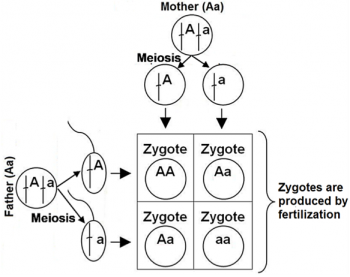Serendip is an independent site partnering with faculty at multiple colleges and universities around the world. Happy exploring!
Understanding How Genes are Inherited via Meiosis and Fertilization
 In this minds-on activity, students answer analysis and discussion questions to learn how a child inherits one copy of each gene from each parent via the processes of meiosis and fertilization. They analyze how the processes of meiosis and fertilization result in the alternation between diploid and haploid cells in the human lifecycle.
In this minds-on activity, students answer analysis and discussion questions to learn how a child inherits one copy of each gene from each parent via the processes of meiosis and fertilization. They analyze how the processes of meiosis and fertilization result in the alternation between diploid and haploid cells in the human lifecycle.
To learn how meiosis produces genetically diverse gametes, students analyze the results of crossing over and independent assortment.
Then, students follow the alleles of a human gene from the parents' body cells through gametes and zygote to a child’s cells. They learn how the outcomes of meiosis and fertilization can be represented in a Punnett square.
A brief final section contrasts sexual reproduction with asexual reproduction.
This activity can be used to introduce meiosis and fertilization or to review these processes. A hands-on version of this activity is available as “Meiosis and Fertilization – Understanding How Genes Are Inherited”.
The Student Handout is available in the first two attached files and as a Google doc designed for use in online instruction and distance learning. The Teacher Notes, available in the last two attached files, provide instructional suggestions and background information and explain how this activity supports the Next Generation Science Standards (NGSS).
| Attachment | Size |
|---|---|
| MeiosisFertilization SH.docx | 1.83 MB |
| MeiosisFertilization SH.pdf | 800.3 KB |
| Meiosis Fertilization TN.docx | 1.4 MB |
| Meiosis Fertilization TN.pdf | 425.13 KB |











Comments
2022 revision
The 2022 revision improved the wording of some of the questions in the Student Handout. I also added information and clarified some points in the Teacher Notes.
Ingrid
2021 revision
The main revision has been a change in the symbols for the alleles of the genes on the model chromosomes to avoid confusion between lower case and capital letters (e.g., s and S).
Ingrid
Comments on activities
These activities look good, but as a general rule, I avoid having 2 pairs of chromosomes since this number 2 is confusing:
each double helix has 2 strands
each chromosome can consist of 2 sisters
A pair of homologs is 2 chromosomes
If often use an odd number of pairs. This can help illustrate the point that if there are on odd number of chromosomes in a cell, meiosis 1 must have been completed.
How many pairs of chromosomes?
Thank you for your comment. As always in teaching, each of us needs to balance competing priorities. In question 18 concerning independent assortment, we show two pairs of homologous chromosomes to illustrate the locations of the defined genes on two identified human chromosomes. I chose this approach because it helps students to understand the whole point of chromosomes and meiosis, and it would be unduly complicated to include a third pair of chromosomes with another gene. I recognize that other teachers will have different priorities which perhaps could be accommodated by editing the word version or Google doc of the Student Handout.
Ingrid
Post new comment